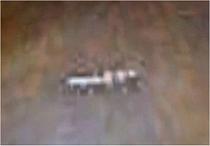NASA: "Bio-Station Alpha and Face on Mars are not artificial structures"
According to
“Mr. Martines posted a video of the 'station' on YouTube which has been viewed more than 200,000 times.
Martines has since taken his video offline, and it can be seen at the following URL
http://news.ninemsn.com.au/technology/8257609/mysterious-structure-discovered-on-mars“On the video, he talks through the discovery he has named ‘Bio-Station Alpha. ‘It's very unusual in that it's quite large, it's over 700 feet (210m) long and 150 feet (45m) wide. It looks like it's a cylinder or made up of cylinders," he says.
“’It could be a power station or it could be a biological containment or it could be a glorified garage — hope it's not a weapon.
“’I don't know if NASA even knows about this.’”
HiRISE director: Bio-Station Alpha is pixelization
The
principal investigator of HiRISE telescope orbiting Mars says "Bio-Station Alpha" is “simply a glitch in the image caused by cosmic energy interfering with the camera.”“’It looks like a linear streak artifact produced by a cosmic ray,’ said Alfred McEwen, a planetary geologist at the Lunar and Planetary Lab at the University of Arizona and the director of the Planetary Imaging Research Laboratory. McEwen is the principal investigator of the High Resolution Imaging Science Experiment (HiRISE), a powerful telescope currently orbiting Mars.
“Cosmic rays are extremely energetic particles emitted by the sun and other stars. For the most part, the Earth's protective magnetosphere blocks them from hitting the planet's surface, McEwen explained. ‘But with space images that are taken outside our magnetosphere, such as those taken by orbiting telescopes, it's very common to see these cosmic ray hits. You see them on optical images and a lot of the infrared images too," he told Life's Little Mysteries.’
“As a cosmic ray passes through a camera's image sensor, it deposits a large amount of its electric charge in the pixels that it penetrates. If the particle passes through at a shallow angle to the plane of the camera, it affects several pixels along its path. The result is a bright streak on the image.
“’The digital compression software that converts the image into a JPEG file then "sort of smears out the image, giving it that pixelated look,’ McEwen said. What started as a clear streak in high-resolution turns into a streak that, in the armchair astronaut's words, looks like it is ‘made up of cylinders.’”
“McEwen said that the cosmic ray streak would be much easier to recognize in the raw, pre-compressed image, but many orbiters and telescopes have contributed imagery to create the Mars map, and Google doesn't identify the source image.
“’I can't tell whether this image was taken by Viking or what,’ McEwen said. ‘The people at Google need to document what the heck they're doing. They should be able to identify what the source of their information is, and let people know so they can go back and look at the raw data.’”
Continuing Life on Mars coverup - NASA stating Face on Mars is not artificial structure
By linking Bio-Station Alpha and the Face on Mars and denying publicly that the Face on Mars is an artificial structure, NASA is continuing its coverup of both ancient and current indigenous life on Mars.
In an article on the huge, simian visage found in the Cydonia region of Mars known as The Face on Mars, the late Dr. Tom van Flandern, former chief astronomer of the U.S. Naval Observatory, concluded that the probability that The Face on Mars is an artificial structure exceeds “a thousand billion billion to one.”
Read more?
Internet site reference:
NASA: "Bio-Station Alpha and Face on Mars are not artificial structures" - Seattle exopoliticsComments
There are 0 comments on this post













